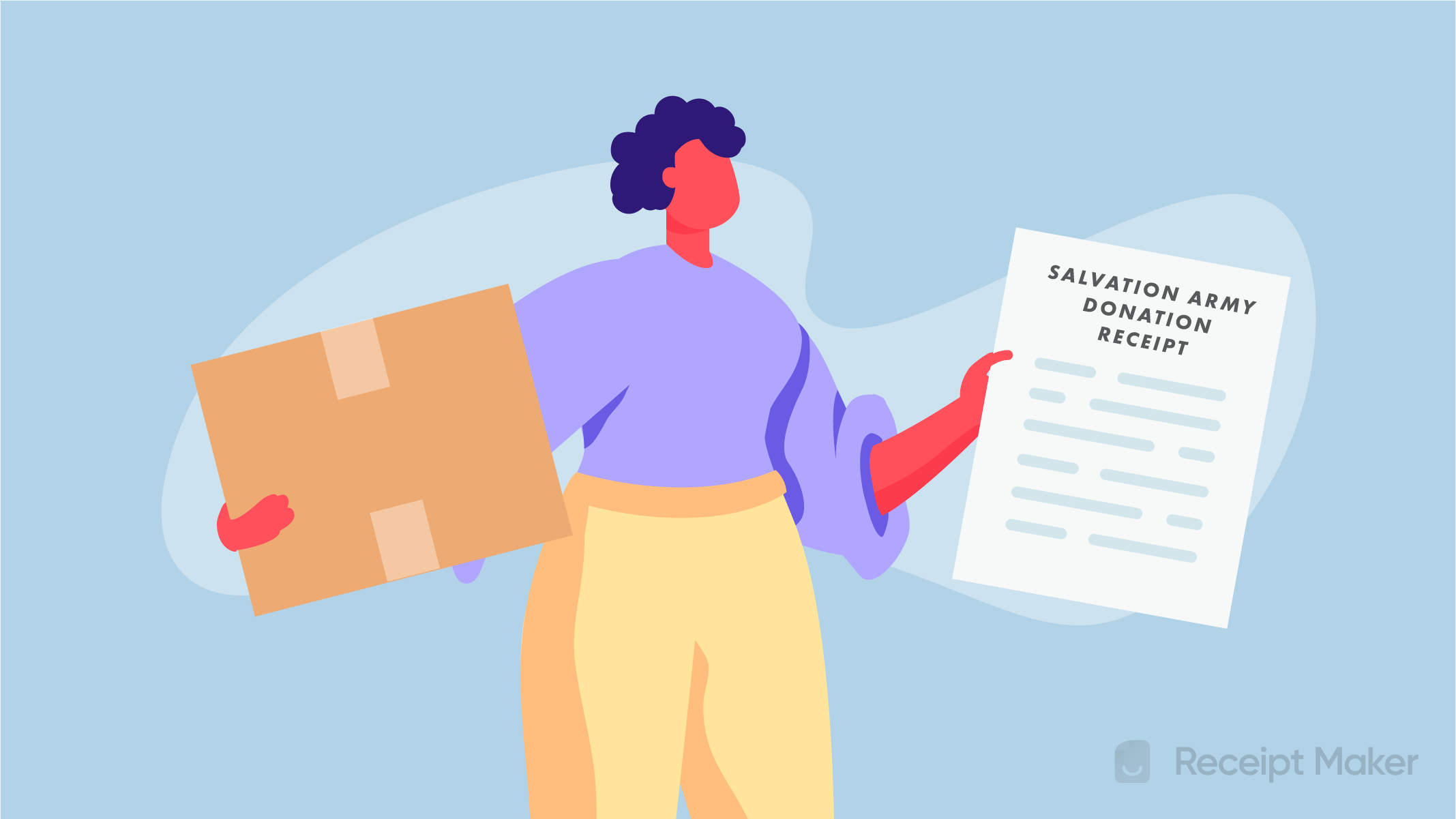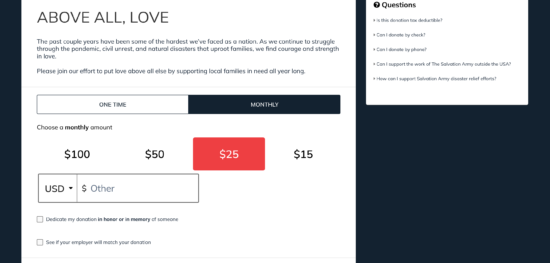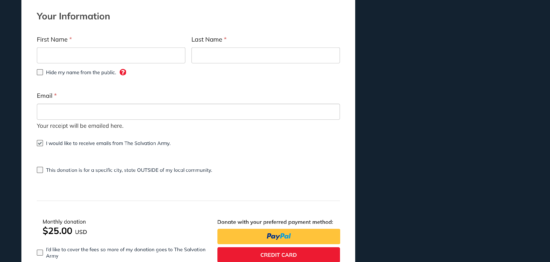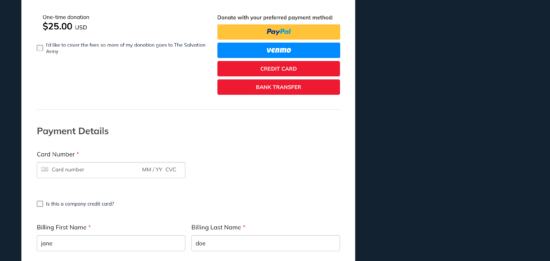
It includes details about the contribution, such as the amount of physical description (for in-kind gifts) and the date the donor donated. It also includes the donor’s contact information and identifying information about the Salvation Army. Donors can use this donation receipt to claim a charitable tax deduction on their IRS tax returns. Copies of all of a donor’s receipts are logged in their online Salvation Army donor account.
Table of Contents
- What is the Salvation Army?
- How to Donate (4 Steps)
- Where Does the Money Go?
- Salvation Army Resources
What is the Salvation Army?
The Salvation Army is a 501(c)(3) nonprofit organization that provides services for many human needs, including but not limited to disaster relief, domestic abuse, homelessness, human trafficking, hunger, job support, substance abuse rehabilitation, veteran support, and youth development. The organization started in 1865 in the United Kingdom. It assists 30 million Americans annually, has 1.8 million members, and has a presence in 131 countries worldwide. The organization considers itself a worldwide evangelical Christian church. It uses a three (3) pronged approach to “meet human needs in His name without discrimination.”
- Assess the Need;
- Build the Programs; and
- Invest in the Community.
How to Donate (4 Steps)
Step 1: Donation Type and Amount
Visit the Salvation Army’s online donation portal. Select the donation type (one time or monthly) and select or enter the donation amount. The donor can also choose to donate in honor of another person and check if their employer matches employee charitable contributions. 
Step 2: Donor Information
Enter the donor’s name and email address. There is an option to donate anonymously. 
Step 3: Payment Details
Select the payment method (Bank Transfer, Credit Card, PayPal, or Venmo). For this explanation, we will use a credit card. The donor can choose to add the cost of the processing fees associated with their contribution. Finally, enter the credit card details and billing address. 
Step 4: Verify and Submit
Click the box next to “I’m not a robot.” Then click “Donate” to submit the donation. 
Other Ways to Donate
In-Kind Gifts Donors can either drop off donations at Salvation Army Drop-Off Locations or request for a Salvation Army truck to pick up a gift from their home or workplace. The in-kind contributions most commonly received by the Salvation Army are
- Appliances;
- Clothing;
- Furniture;
- Household items; and
- Vehicles.
- Planned Giving (annuities, wills, and trusts)
- Securities (bonds, mutual funds, and stocks)
Corporate Partnerships The Salvation Army partners with fifty-eight (58) corporations in the U.S. in a variety of ways:
- Cause marketing;
- Disaster support;
- Grants;
- In-kind contributions;
- Point-of-sale round-up programs;
- Matching gifts;
- Seasonal fundraising; and
- Volunteer engagement.
Where Does the Money Go?
The Salvation Army provides services targeting a large number of human needs in communities all over the world. This list explains where SA spends its donated funds.
- After-School Programs
- Disaster Relief
- Domestic Abuse Shelter and Support
- Fighting Human Trafficking
- Food Insecurity
- Job Support
- LGBTQ Support
- Love Beyond
- Pathway of Hope
- Rehabilitation Services
- Services for the Aging
- Shelter
- Veterans
- Dance, art, and music programs;
- Homework assistance and counseling;
- Parental involvement coaching; and
- Sports, clubs, and extracurricular activities.
- Assists with droughts, earthquakes, floods, hurricanes, tornadoes, wildfires, and other natural disasters; and
- Provides nearly 800,000 disaster survivors with healing and support annually.
Domestic Abuse Shelter and Support
- Cascade Women’s and Children’s Center;
- Northwest Division Center; and
- The Pheonix Elim House.
- Comprehensive case management for survivors; and
- Public awareness campaigns.
- Community gardens provide free produce and volunteer opportunities; and
- Food pantries offer meal programs for their communities.
- Continued support (financial planning, insurance, childcare, etc.);
- Educational and job-training opportunities;
- Job placement assistance; and
- Skill-set evaluations.
- Food insecurity;
- Job training;
- Shelters;
- Substance abuse help; and
- Teenage suicide prevention.
- All donations go directly to holiday-related services.
Pathway of Hope The Pathway of Hope program tackles generational poverty. It provides case management to individuals and families built to address how poverty affects many generations. The program focuses on the core causes of poverty instead of only treating the symptoms. The three (3) leading causes of generational poverty are:
- Lack of job opportunities;
- Underserved educational environments; and
- Unstable housing.
The five (5) tiered approach focuses on each client’s unique needs:
- Catalyze community collaboration in service of shared clients;
- Focus on hope as a measured outcome, representing the relational, spiritual outcome sought by The Salvation Army in its work;
- Move families from vulnerability to stability and self-sufficiency, tracking progress along the way;
- Provide targeted services to families with a desire to take action; and
- Use the Salvation Army’s internal resources to align with clients’ goals.
- Build work and social skills;
- Combat addiction;
- Regain health and stability; and
- Restore families.
- Activities;
- Adult Day Care Centers;
- Community; and
- Residences.
- Homeless shelters;
- Permanent supportive housing;
- Re-entry resources; and
- Transitional housing.
- Adult rehabilitation centers;
- Community network; and
- Shelters.
